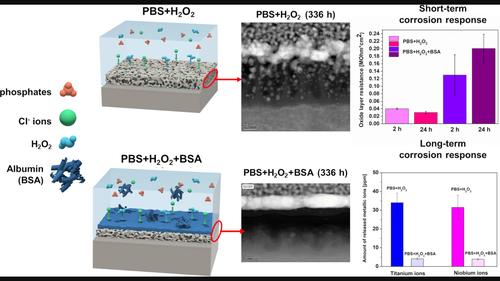当前位置:
X-MOL 学术
›
J. Biomed. Mater. Res. Part B Appl. Biomater.
›
论文详情
Our official English website, www.x-mol.net, welcomes your feedback! (Note: you will need to create a separate account there.)
Albumin suppresses oxidation of TiNb alloy in the simulated inflammatory environment
Journal of Biomedical Materials Research Part B: Applied Biomaterials ( IF 3.4 ) Pub Date : 2024-03-27 , DOI: 10.1002/jbm.b.35404 Agata Sotniczuk 1, 2 , Damian Kalita 1 , Witold Chromiński 1, 2 , Magdalena Matczuk 3 , Marcin Pisarek 4 , Halina Garbacz 2
Journal of Biomedical Materials Research Part B: Applied Biomaterials ( IF 3.4 ) Pub Date : 2024-03-27 , DOI: 10.1002/jbm.b.35404 Agata Sotniczuk 1, 2 , Damian Kalita 1 , Witold Chromiński 1, 2 , Magdalena Matczuk 3 , Marcin Pisarek 4 , Halina Garbacz 2
Affiliation

|
Literature data has shown that reactive oxygen species (ROS), generated by immune cells during post‐operative inflammation, could induce corrosion of standard Ti‐based biomaterials. For Ti 6Al 4V alloy, this process can be further accelerated by the presence of albumin. However, this phenomenon remains unexplored for Ti β‐phase materials, such as TiNb alloys. These alloys are attractive due to their relatively low elastic modulus value. This study aims to address the question of how albumin influences the corrosion resistance of TiNb alloy under simulated inflammation. Electrochemical and ion release tests have revealed that albumin significantly enhances corrosion resistance over both short (2 and 24 h) and long (2 weeks) exposure periods. Furthermore, post‐immersion XPS and cross‐section TEM analysis have demonstrated that prolonged exposure to an albumin‐rich inflammatory solution results in the complete coverage of the TiNb surface by a protein layer. Moreover, TEM studies revealed that H2 O2 ‐induced oxidation and further formation of a defective oxide film were suppressed in the solution enriched with albumin. Overall results indicate that contrary to Ti 6Al 4V, the addition of albumin to the PBS + H2 O2 solution is not necessary to simulate the harsh inflammatory conditions as could possibly be found in the vicinity of a TiNb implant.
中文翻译:

白蛋白抑制模拟炎症环境中TiNb合金的氧化
文献数据表明,免疫细胞在术后炎症过程中产生的活性氧(ROS)可能会引起标准钛基生物材料的腐蚀。对于钛 6铝 4V合金中,白蛋白的存在可以进一步加速这一过程。然而,对于 Ti β 相材料(例如 TiNb 合金),这种现象仍未得到探索。这些合金由于其相对较低的弹性模量值而具有吸引力。本研究旨在解决白蛋白如何影响模拟炎症条件下TiNb合金的耐腐蚀性能。电化学和离子释放测试表明,白蛋白在短期(2 和 24 小时)和长期(2 周)暴露期间均显着增强耐腐蚀性。此外,浸入后 XPS 和横截面 TEM 分析表明,长时间暴露于富含白蛋白的炎症溶液中会导致蛋白质层完全覆盖 TiNb 表面。此外,TEM 研究表明 H2 氧2 在富含白蛋白的溶液中,诱导的氧化和有缺陷的氧化膜的进一步形成被抑制。总体结果表明,与 Ti 相反 6铝 4V,向PBS+H中添加白蛋白2 氧2 不需要溶液来模拟在 Ti-Nb 植入物附近可能出现的严酷炎症条件。
更新日期:2024-03-27
中文翻译:

白蛋白抑制模拟炎症环境中TiNb合金的氧化
文献数据表明,免疫细胞在术后炎症过程中产生的活性氧(ROS)可能会引起标准钛基生物材料的腐蚀。对于钛



























 京公网安备 11010802027423号
京公网安备 11010802027423号